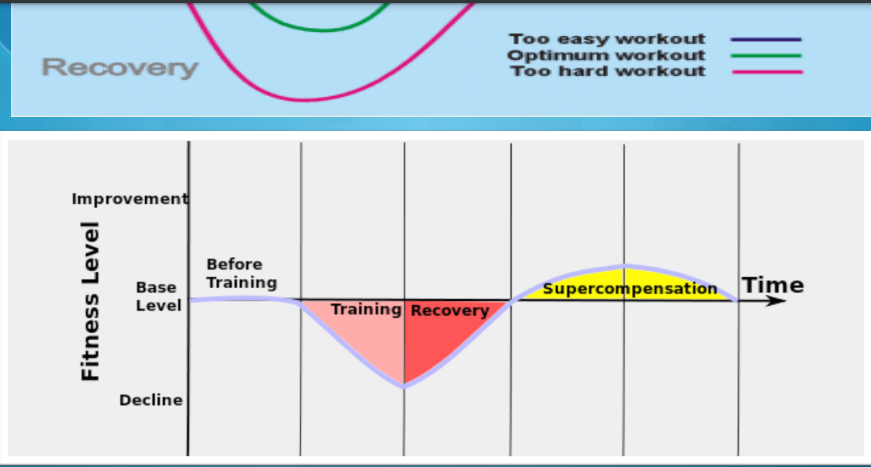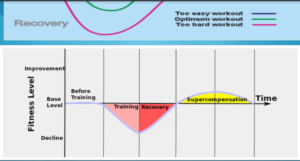🌟What is Programming?🌟
Programming is “the organisation and planning of training should be considered an art that is based on science” Bompa (1999). A well organised plan:
• Eliminates random and aimless training practices
• Removes poor training concepts or philosophies
• Focuses on practices that are logically devised, meticulously planned
and based on science
Training Plan Goal should stimulate specific physiological responses according to a planned design so that certain performance outcomes are stimulated at the appropriate time. Knowing what a person is to recover from also needs planning which is why intense periods of training are intertwined with periods of less intense training or rest designed to allow the
athlete/clients to recover and adapt (General Adaptation Syndrome) from the previous training cycle. This is why it is very important to have a stress management system with your training. A stress management system helps prevent an athlete/client from burnout and over training which can lead to sickness.
🌟Things to consider when making a training plan:
-
How much fatigue will the training intervention stimulate?
-
How will the athlete/client respond to the fatigue?
-
How the stimulus induced relates to the training plan
A big driver of programme design is knowing what training stimulus you need to provide for the athlete/client. One of the best ways to do this is focus in on specific needs and wants, and understand the principles of training as they relate to a training cycle and programme design.
🌟Principle 1: Adaptation
Process of adjusting to a physical, environmental or psychological stress or stimulus.
General Adaptation Syndrome (Selye,1957):Stress causes a temporary reduction in performance/function which is followed by an adaptation that excels the body’s performance. Training stimulus can be interpreted as a ‘shock’ to the body. To keep a training stimulus it is very important to avoid accommodation. Accommodation is a biological law that once the body adapts to a stimulus, the body will halt progress or get worse at a specific skill or protocol. For example using the same squat with the same weights or percentages every week will not make you stronger. In face you might get worse or burn out. This example is very common which is why seeking someone with programming skills is vital to progress in the gym. General Adaptation Syndrom is best described in the graph below:
🌟Principle 2: Specificity
The body/system stressed will adapt to the stimulus imposed in a very specific manner which is why training needs to get more specific as the athlete develops and progresses through a training programme. Understanding of the demands of a sport will ensure a trainer/coach devises and selects specific activities that prepare the athletes/clients to meet the challenges and demands they face.
Scientific support
Kanehisa & Miyashita (1983): During strength training, strength gains are confined to speed of movement used in the
training process.
Hennessy et al (2005):
Gains in agility are best achieved through specific agility training as opposed to linear short distance sprint training.
With these details in mind it is important to understand where or what an athlete/client needs to work on to improve specific aspects of the sport. For example in the beginning of a training programme for a field based sport, it would be ideal to work on mechanics of linear speed and acceleration. This then develops into curved runs with acceleration and deceleration which will then in turn, improve the athlete/clients ability to get to a ball.
Therefore it would not be beneficial or specific to have have an athlete in a sport that requires multiple bouts of sprinting, running steady state long distance activity in season. Yet we see this all the time in amateur sports.
🌟Example: Rugby
-
Distances covered generally less than 30m at one time
-
Combination of acceleration over short distances along with
changes in direction and footwork, along with deceleration
Scientific support
Kanehisa & Miyashita (1983): During strength training, strength gains are confined to speed of movement used in the training process
Hennessy et al (2005): Gains in agility are best achieved through specific agility training as opposed to linear short distance sprint training
Principle 3: Overload
Hennessy (2010): The body or system trained adapts to the stress or stimulus if it is worked harder or longer than ‘normal’ but it is worth keeping in mind that detraining could occur in the absence of ‘overload’ within a programme for a period of time. Too great an overload may see a negative adaptation. The ideal amount to progress from one week to the next, as a general rule would be about 2.5% – 5%. This is all depends on training age and the type of exercise, Kraemer & Fleck (1987). Otherthing to take into consider when planning overload are:
-
Frequency of training
-
Increase in volume
-
Decreasing rest times
-
Increasing intensity
-
Adjusting tempo
-
Increase resistance
Positive adaptation occurs as a result of ‘overload’ so apply ‘overload’ in a progressive manner to ensure consistent
adaptation.
🌟Principle 3: Recovery
Recovery is not just the rest in between sets but also includes:
-
Lower stress weeks in a training plan
-
Off season
-
Strategies such as saunas, ice baths, contrast bathing massage…………
-
Holidays
-
Recovery specific training sessions.
Recovery is needed to regenerate, restore and rehabilitate. Recovery can be build into the programme in the form of a deload or lower stress week every 4 to 6 weeks or built into a wave structure when the percentages are already pre planned. For example if you were to use a pendulum wave programme for maximal work you would use
-
week 1 – 75%
-
week 2 – 80%
-
week 3 – 85%
-
week 4 – 75%
-
week 5 – 80%
-
week 6 – 85%
* week 4 would act as a deload because the percentages were increased over a 3 week period. This helps prepare the CNS for the 85% week and then a deload effect accurs on week 4.
🌟Principle 5: Detraining
Detraining is a process where gains made through training are lost when training ceases. Time period involved along with training age impact the level of detraining that occurs. If someones training age is not very high, under 3 years then they MUST complete a block of training before they move onto the next phase of training. The start of any programme for a beginner should focus on GPP, General Physical Preparedness
These are a few examples of the priciples of training that should be considered. It is advisable to seek professional help when designing gym programmes so that the training you are doing that is meant to help you feel happy and increase performance, then turns into burnout.
Ill leave you with these questions for thought.
-
Do you attend a gym with no plan?
-
If not why do you not have a plan? You wouldnt build your house without planning it.
-
If you do have a plan, why did you feel you could make it yourself? was it because you copied someone else that is “winging it”
🌟Following a plan made for someone else has consequences.🌟
If you want to work with me to improve your strength, conditioning or your recovery from training/sports, then leave an email with the word “interested” and we can discuss at mackelitejmc@gmail.com
References
¡ Narici, MV, Roi, GS, Landoni, L., Minetti, AE & Cerretelli, P. (1989) Changes in
force, cross-sectional area and neural activation during strength training and
detraining of the human quadriceps. European Journal of Applied Physiology, 59:
310-319
¡ Coyle, Martin, Sinacore, Joyner, Hagberg & Holloszy (1984). Time course of loss of
adaptations after stopping prolonged intense endurance training. Journal of Applied
Physiology, 57: 1857-1864
¡ Hakkinen, & Komi (1985). Changes in electrical and mechanical behaviour of leg
extensor muscles during heavy resistance strength training. Scandanavian Journal of
Sports Science, 7: 55-64
¡ Costill et al. (1988). Effects of repeated days of intensified training on muscle
glycogen and swimming performance. Medicine Science in Sports & Exercise. 20:
249-254
¡ Hennessy, L. (2010). Fitness Conditioning Workshop Notes. Setanta College


